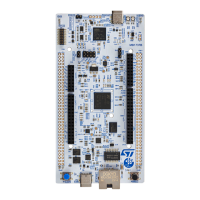6.4.2 Programming/debugging when the power supply is not from STLINK-V3EC (STLK)
VIN, 5V_EXT, or 5V_UCPD can be used as external power supplies in case the current consumption of the
Nucleo with expansion boards exceeds the allowed current on USB. In such a condition, it is still possible to use
USB for communication for programming or debugging only.
In this case, it is mandatory to power the board first using VIN, 5V_EXT, or 5V_UCPD then connect the USB
cable to the PC. Proceeding this way the enumeration succeeds, thanks to the external power source.
The following power sequence procedure must be respected:
1. Set the JP3 jumper according to the selected 5 V power source.
2. Connect the external power source according to JP3.
3. Power on the external power supply.
4. Check that the 5 V green LED (LD5) is turned ON.
5. Connect the PC to the USB ST-LINK connector (CN5).
If this sequence is not respected, the V
BUS
from STLINK-V3EC might power the board first, and the following risks
might be encountered:
• If the board needs more than 500 mA current, the PC might be damaged or the current limited by the PC.
Therefore, the board is not powered correctly.
• 500 mA is requested at enumeration. So, there is a risk that the request is rejected and the enumeration
does not succeed, as the PC cannot provide such a current. Consequently, the board is not power supplied
and the 5 V green LED (LD5) remains OFF.
6.4.3 Power supply output
5V
When the Nucleo board is powered by USB, VIN, or 5V_EXT, the 5V present on CN8 pin 9 or CN11 pin 18 can be
used as an output power supply for an ARDUINO
®
shield or an extension board. In this case, the maximum
current of the power source specified in
Table 8 must be respected.
3V3
The internal 3V3, on CN8 pin 7 or CN11 pin 16, can be used also as a power supply output. The current is limited
by the 1.3 A maximum current capability of the U16 regulator concerning the Nucleo board with shield
consumption.
6.4.4 Internal power supply
The Nucleo boards are designed to support two specific voltage configurations:
• 3V3 VDD configuration to reach the Nucleo low-power mode with 3.3 V
• 1V8 VDD configuration to demonstrate the MCU low-voltage capability
JP5 is used to set VDD. Refer to Table 5 for details.
3V3
Regardless of the 5V power source, an LDO is used to switch from 5V to the 3V3 default power source of the
VDD. The maximum current capability of this source is 1.3 A. To select the 3V3 voltage for the VDD, set the JP5
jumper on [1‑2].
A solder bridge (SB30) is used to disconnect the LDO output when an external 3V3 is applied to the Nucleo
board:
• SB30 ON: U16 LDO output provides a 3V3 power supply (default configuration).
• SB30 OFF: U16 LDO output does not provide 3V3. An external 3V3 is needed.
1V8
An adjustable LCD can be used for the MCU to work at 1V8. This helps to demonstrate the 1V8 MCU capability.
The LDO capability is also 1.3 A. Before using the 1V8 voltage, it is necessary to check that all interfaces are 1V8
compatible and the maximum current requested does not exceed 1.3 A. To select the 1V8 voltage for the VDD,
set the JP5 jumper on [2‑3].
UM3276
Hardware layout and configuration
UM3276 - Rev 1
page 19/40

